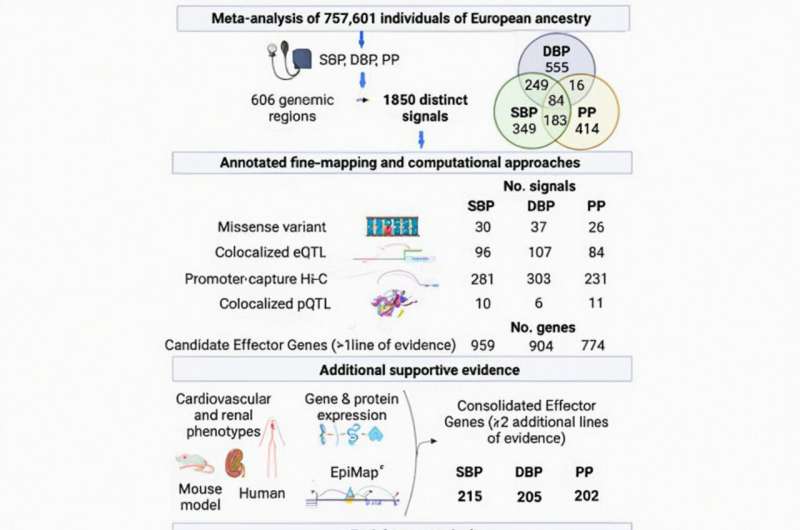September 12, 2023 report
This article has been reviewed according to Science X's editorial process and policies. Editors have highlighted the following attributes while ensuring the content's credibility:
fact-checked
peer-reviewed publication
trusted source
proofread
Multi-omic integration of hypertension reveals potential effector genes

Researchers at Queen Mary University of London, UK, have traced hypertension to its genetic sources. In a paper, "Integration of genetic fine-mapping and multi-omics data reveals candidate effector genes for hypertension," published in The American Journal of Human Genetics, the team conducted genome-wide association studies (GWAS) on blood pressure (BP) to identify causal variants and candidate effector genes for systolic BP (SBP), diastolic BP (DBP) and pulse pressure (PP).
The study provides hundreds of previously unreported candidate effector genes associated with BP traits by integrating various data sources, including mouse studies, human disorders, gene expression, and tissue abundance data.
Among these signals, the study found that for more than 20% of them, a single variant accounted for a high posterior probability of driving the association. These variants included amino acid variants in previously identified BP-related genes like SLC39A8, ADRB2, and DBH, as well as previously unreported candidate genes like NRIP1 and MMP14.
The study observed 532 distinct signals associated with BP traits, with 84 of the signals associated with all three traits (SBP, DBP and PP). The study also identified 215 candidate genes for SBP, 205 for DBP, and 202 for PP, for a total of 436 unique genes consolidated as potential effector genes for BP regulation.
Gene set enrichment analysis revealed significant enrichment for various biological processes related to BP regulation, including circulatory system development, embryo development and urogenital system development.
Hypertension is a condition in which the blood vessels have persistently raised pressure. The higher the pressure, the harder the heart has to pump. While common, it can be a serious health risk if not treated, and is a a major cause of premature death worldwide.
According to the World Health Organization, an estimated 1.28 billion adults aged 30–79 years worldwide have hypertension, affecting upwards of one in four men and one in five women.
There has been consistent research replication of human genetic associations with blood pressure (BP) traits over the last decade, yet identifying the effector genes responsible for these associations has remained elusive.
The current study captures a significant relationship between the general genetic associations and specific effector genes. By highlighting candidate genes and potential pathways, further research can explore these gene activities, interactions and mechanisms for future drug development targeting hypertension.
More information: Stefan van Duijvenboden et al, Integration of genetic fine-mapping and multi-omics data reveals candidate effector genes for hypertension, The American Journal of Human Genetics (2023). DOI: 10.1016/j.ajhg.2023.08.009
© 2023 Science X Network





















